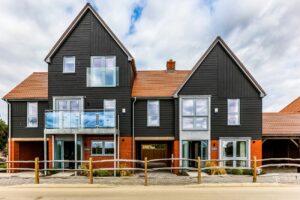Cement Fibre Cladding: Sustainability in Construction
In the ever-evolving landscape of sustainable construction, cement fibre cladding stands tall as a symbol of eco-consciousness and versatility. In this insightful exploration, we delve into the environmental strength of cement fibre cladding, shedding light on the many benefits and considerations.
Advantages of Cement Fibre Cladding
- Easy Installation
Lightweight Material: Cement fibre boards or sheets are easy to handle and position during installation. Whether fitted by hand or using a nail gun, the lightweight nature of these boards cuts labour costs.
- Durability and Weather Resistance
Long Life Expectancy: Cement fibre cladding boasts a life expectancy of 40-50 years. It remains unaffected by rot, extreme weather conditions, and moisture.
Fire Resistance: The material is inherently fire-resistant, providing an additional layer of safety, reenforcing its reliability and protection properties.
- Minimal Maintenance
No Repainting Required: Unlike vinyl or PVC cladding, cement fibre boards require minimal maintenance and do not need repainting.
Easy Cleaning: A simple soap-and-water solution keeps the cladding looking fresh.
- Environmentally Friendly
Reduced Additives: Cement fibre cladding uses minimal additives (along with sand, cement, and water) in its production. This eco-conscious approach sets it apart from other cladding types.
Less Dust: Working with fibre cement generates less dust compared to alternative materials, resulting in a healthier working environment for installers.
- Pest Resistance
No Vulnerability: Unlike timber or vinyl cladding, cement fibre cladding is impervious to pests. Its composition of cement and reinforced cellulose fibres prevents damage from woodworm or nesting birds.
Environmental Considerations
- Production Process
While cement fibre cladding itself is durable, the production process involves cement, which has a significant environmental footprint. Manufacturers must continue to explore sustainable production methods to mitigate ecological footprints.
- End-of-Life Disposal
Proper disposal of fibre cement products at the end of their life cycle is crucial. Embracing recycling or repurposing these materials underscores a commitment to environmental sustainability and the protection of the planet.
- Energy Efficiency
When used as external cladding, cement fibre enhances a building’s energy efficiency. Improved insulation and thermal performance reduce heating and cooling energy consumption, resulting in lower greenhouse gas emissions, helping to foster a greener future.
Each of us contributes to safeguarding the environment, and integrating sustainable materials represents a pivotal step in this collective endeavour. Cement fibre cladding embodies a harmonious blend of functionality, aesthetics, and environmental stewardship. As we forge ahead in constructing the future, embracing sustainable materials such as cement fibre not only enhances our structures but also fosters a greener, more robust built environment for generations to come.

